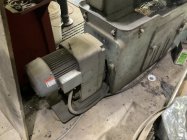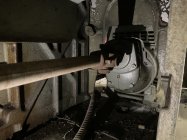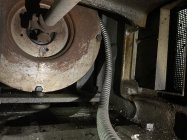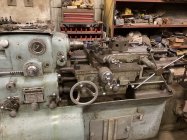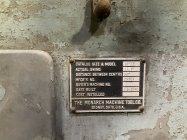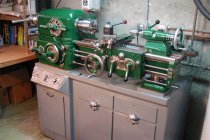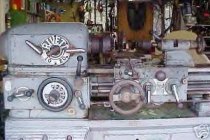- Home
- Forums
- Q&A: Gear, Gun Projects, and Gunsmithing
- Gun Project Questions & Gunsmithing
- Advanced Gunsmithing & Engineering
You are using an out of date browser. It may not display this or other websites correctly.
You should upgrade or use an alternative browser.
You should upgrade or use an alternative browser.
Monarch 10ee Lathe Barreling Info Request
- Thread starter Geno C
- Start date
Kurz
Silver $$ Contributor
Here is a pretty good thread describing the 10EE Toolroom lathes:
https://www.practicalmachinist.com/vb/monarch-lathes/what-allure-10ee-392011/
I bought one from a local man who was certified to refurbish Monarch lathes. His work and storage area was phenomenal! Think kid in candy shop... I sold it later to fund other machines. I now have a Rivett and a
HLV-H, Hardinge. The Rivett is original (looks like the 10EE) and fully tooled and the Hardinge was refurbished and fully tooled. I have to have manual lathes around for some types of work.
https://www.practicalmachinist.com/vb/monarch-lathes/what-allure-10ee-392011/
I bought one from a local man who was certified to refurbish Monarch lathes. His work and storage area was phenomenal! Think kid in candy shop... I sold it later to fund other machines. I now have a Rivett and a
HLV-H, Hardinge. The Rivett is original (looks like the 10EE) and fully tooled and the Hardinge was refurbished and fully tooled. I have to have manual lathes around for some types of work.
butchlambert
Site $$ Sponsor
I loved my 10EE, but the only way you could chamber a rifle barrel was to have bushings fitted to your barrel in the headstock. Mine had ELSR, but it was much quicker to thread the conventional way. The ELSR was for production. Spindle bore was plenty big.
I believe Jackie chambered in his in the way past.
They are a wonderful heavy and very smooth lathe. Price a new one!!
I believe Jackie chambered in his in the way past.
They are a wonderful heavy and very smooth lathe. Price a new one!!
jackieschmidt
Gold $$ Contributor
If it still has the old motor generator motor drive, you will be buying a ton of headaches. This is 1930’s tech designed to meet the needs of that time in a ultra precision tool room lathe. They did that very well.
in recent years, people have been buying them and converting them to a modern frequency drive Systems.
we stripped all of theoriginal drive system out, took the armature out of the DC motor and replaced it with a straight through shaft. We then attached 3 HP PIV drive to the rear of the late and ran a u joint drive shaft to thr input.
This type of modification is probably out of the capabilities of most, but for us, it was a logical fix rather than messing with all of the electronics.
we don’t even have a tail stock on ours. We have the turret assembly.
i chambered A few barrels on it. Let’s just say it would not be my first choice in a gunsmith lathe.
I will take a picture tomorrow and post it.
in recent years, people have been buying them and converting them to a modern frequency drive Systems.
we stripped all of theoriginal drive system out, took the armature out of the DC motor and replaced it with a straight through shaft. We then attached 3 HP PIV drive to the rear of the late and ran a u joint drive shaft to thr input.
This type of modification is probably out of the capabilities of most, but for us, it was a logical fix rather than messing with all of the electronics.
we don’t even have a tail stock on ours. We have the turret assembly.
i chambered A few barrels on it. Let’s just say it would not be my first choice in a gunsmith lathe.
I will take a picture tomorrow and post it.
Last edited:
hpshooter
Gold $$ Contributor
Did you use a constant velocity joint?We then attached 3 HP PIV drive to the rear of the late and ran a u joint drive shaft to thr input.
jackieschmidt
Gold $$ Contributor
jackieschmidt
Gold $$ Contributor
jackieschmidt
Gold $$ Contributor
As the photo shows, just regular sealed u-joints.Did you use a constant velocity joint?
hpshooter
Gold $$ Contributor
Thanks. Was concerned if conventional joints would give a "notchy" power delivery. Looks like your angle on the joints is not to steep.As the photo shows, just regular sealed u-joints.
jackieschmidt
Gold $$ Contributor
They are just about straight.Thanks. Was concerned if conventional joints would give a "notchy" power delivery. Looks like your angle on the joints is not to steep.
The lathe runs very smooth.
If you’re still interested in the machine
There’s a good tutorial on a vfd conversion on practical machinist using a 3-5 hp motor
Basically you make a stub and extend the motor shaft
Fabricate a Mount for the motor
And modify the drive gear for the two speed gearbox or cut another gear. Only problem is you’ll need at least a 14-16” lathe to swing the motor armature to modify the shaft
I met a guy who did one with a 5hp motor
Says it runs smooth and no issues
There’s a good tutorial on a vfd conversion on practical machinist using a 3-5 hp motor
Basically you make a stub and extend the motor shaft
Fabricate a Mount for the motor
And modify the drive gear for the two speed gearbox or cut another gear. Only problem is you’ll need at least a 14-16” lathe to swing the motor armature to modify the shaft
I met a guy who did one with a 5hp motor
Says it runs smooth and no issues
KurtzHere is a pretty good thread describing the 10EE Toolroom lathes:
https://www.practicalmachinist.com/vb/monarch-lathes/what-allure-10ee-392011/
I bought one from a local man who was certified to refurbish Monarch lathes. His work and storage area was phenomenal! Think kid in candy shop... I sold it later to fund other machines. I now have a Rivett and a
HLV-H, Hardinge. The Rivett is original (looks like the 10EE) and fully tooled and the Hardinge was refurbished and fully tooled. I have to have manual lathes around for some types of work.
Do you like your Rivett and Harding better than the monarch E
E ? Any pictures of your lathes? It's always nice to see good machines.
What's the guys name that refurbishes Monarchs and is he still doing it?
Hal
Kurz
Silver $$ Contributor
Do you like your Rivett and Harding better than the monarch E
E ? Any pictures of your lathes? It's always nice to see good machines.
What's the guys name that refurbishes Monarchs and is he still doing it?
The Rivett is my daily driver for handling most manual lathe processes. Smooth, easy to set up and stays within the accuracy parameters for longer periods of time. Yes, I've done some parts replacement and testing over the years just to make sure it lasts into the next century...
My favorite for manual threading and chambering though is the Hardinge. The EE was a little tight for some of the barrel work I do these days but it was a superb machine.
No, I don't have any pictures of any of my machines except for those required for insurance.
The fine gentleman that sold me the Monarch passed on years ago to the great machine shop in the sky. He was a truly fine man and contributed much to those of us who try to practice good machine skills. Unfortunately, the bank got their hands on the disposition and sale of his inventory. It was an awful production, mishandled from the start and favored those whom bank favored. All I could do was watch in horror from the sidelines.
B Nettesheim
Gold $$ Contributor
What model Rivett do you have? I had a 1941 Rivett 1020, which required extensive restoration, but was a wonderful lathe. I sold it back to the good friend who initially started its restoration, when I bought a very nice 1946 Monarch 10EE from him.The Rivett is my daily driver for handling most manual lathe processes. Smooth, easy to set up and stays within the accuracy parameters for longer periods of time. Yes, I've done some parts replacement and testing over the years just to make sure it lasts into the next century...
...snip...
I don't do any barrel work (or any gunsmithing) but I get it about how the EE wouldn't be optimal for it, nor would the Rivett. My EE does have the motor/generator drive, powered by a rotary phase converter and works very well. If it were to ever fail, I would replace it with a VFD, which is what I put on the Rivett.
Rick
Attachments
Upgrades & Donations
This Forum's expenses are primarily paid by member contributions. You can upgrade your Forum membership in seconds. Gold and Silver members get unlimited FREE classifieds for one year. Gold members can upload custom avatars.

Click Upgrade Membership Button ABOVE to get Gold or Silver Status.
You can also donate any amount, large or small, with the button below. Include your Forum Name in the PayPal Notes field.
To DONATE by CHECK, or make a recurring donation, CLICK HERE to learn how.

Click Upgrade Membership Button ABOVE to get Gold or Silver Status.
You can also donate any amount, large or small, with the button below. Include your Forum Name in the PayPal Notes field.
To DONATE by CHECK, or make a recurring donation, CLICK HERE to learn how.










